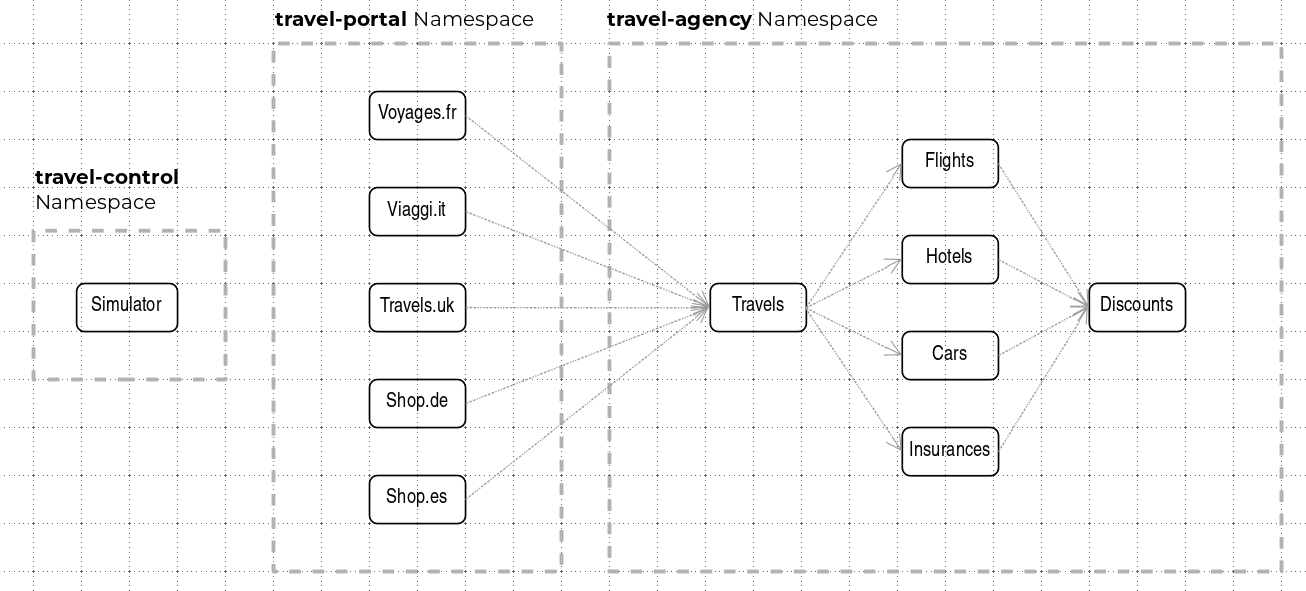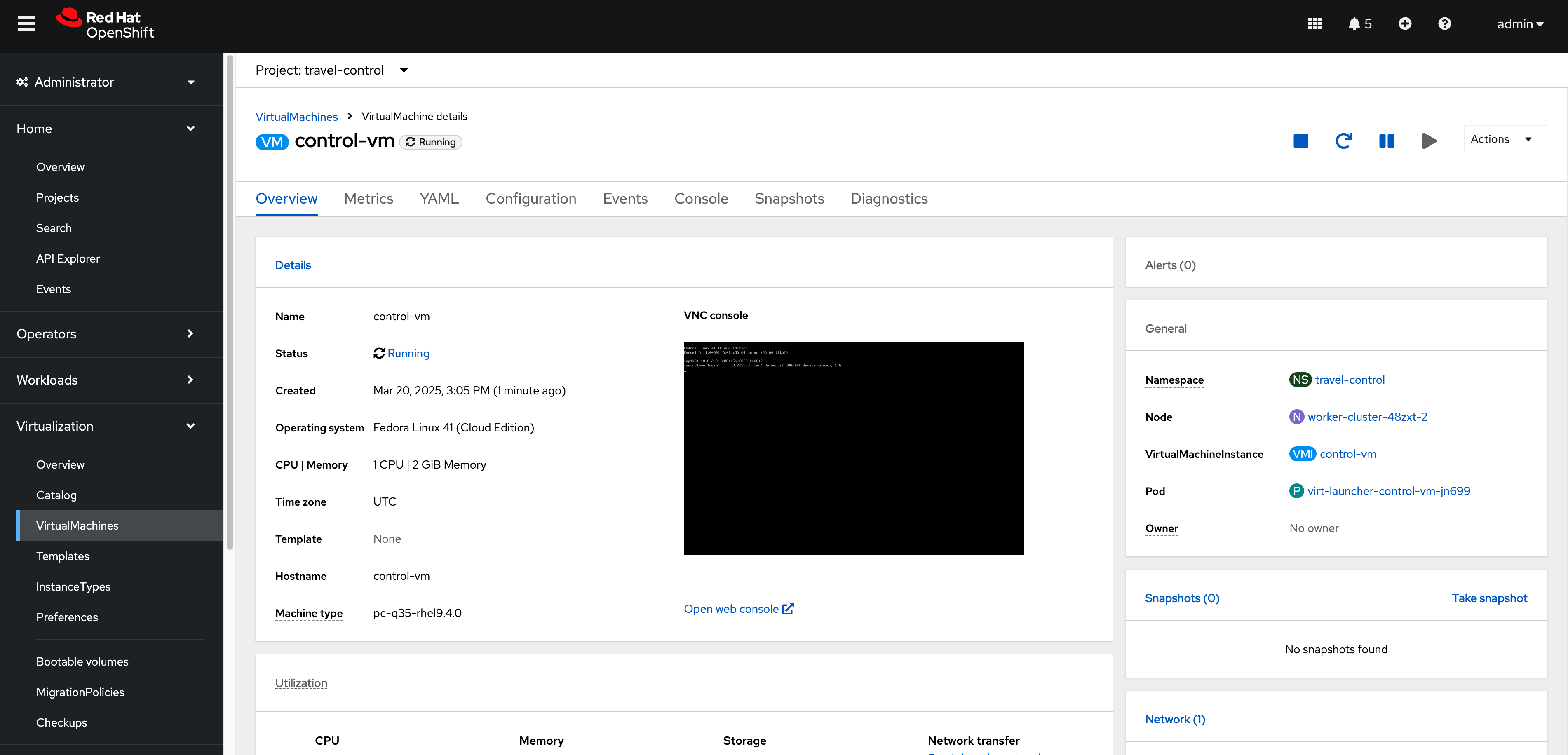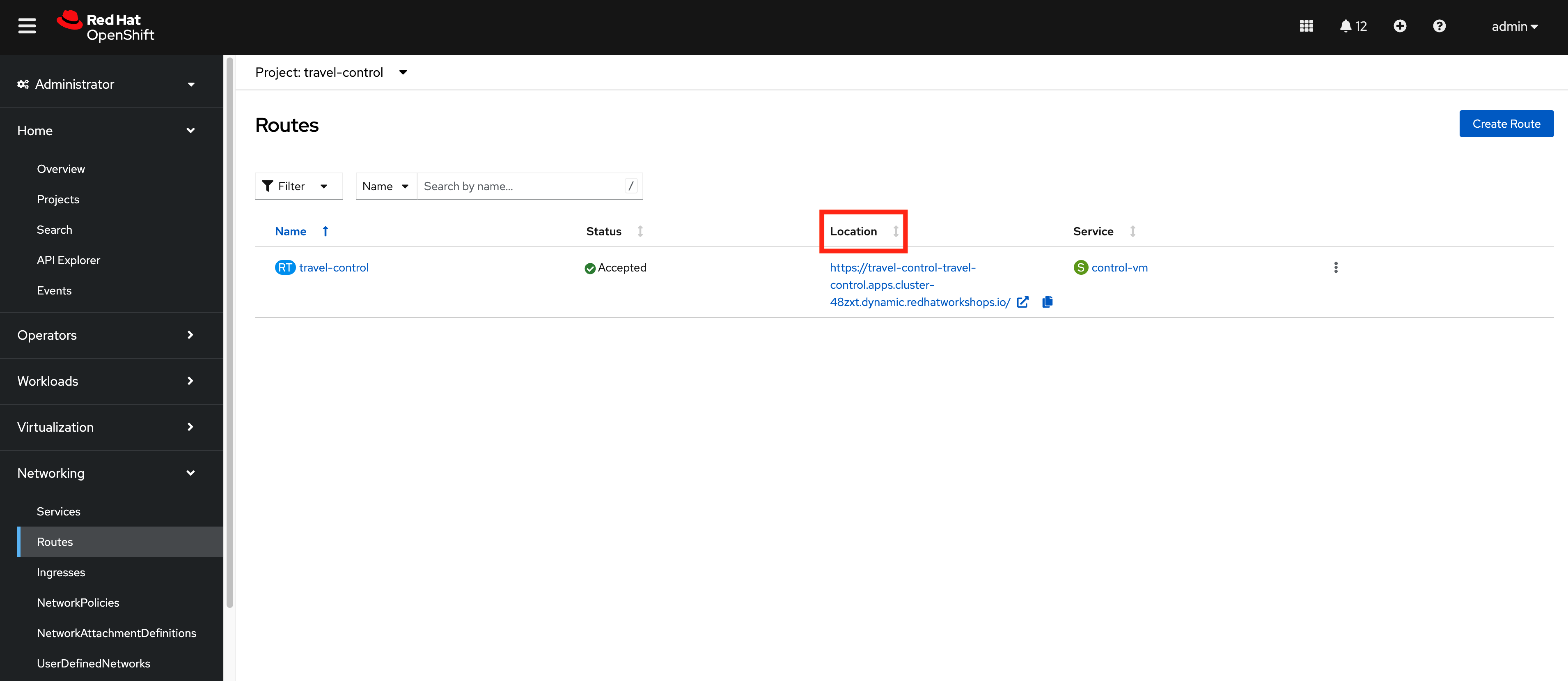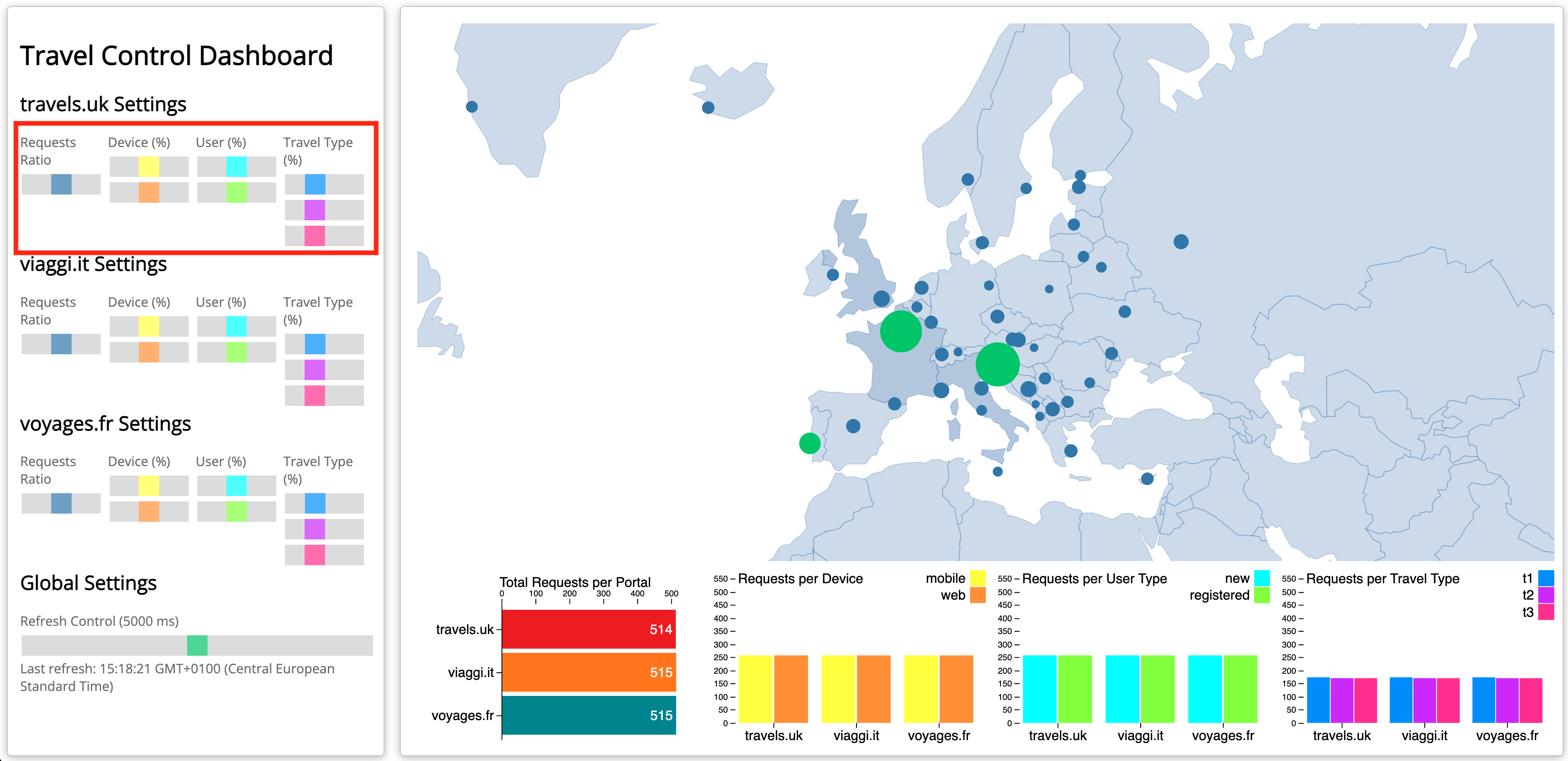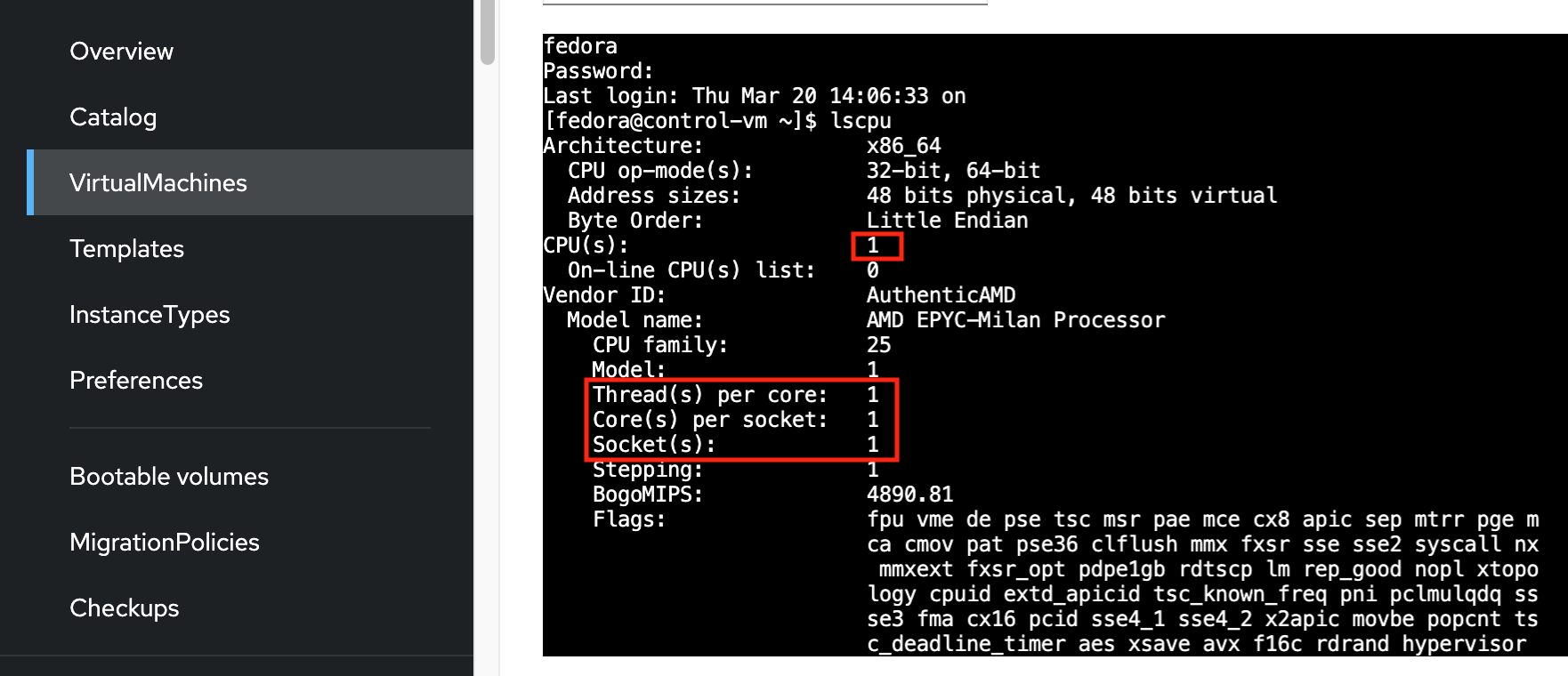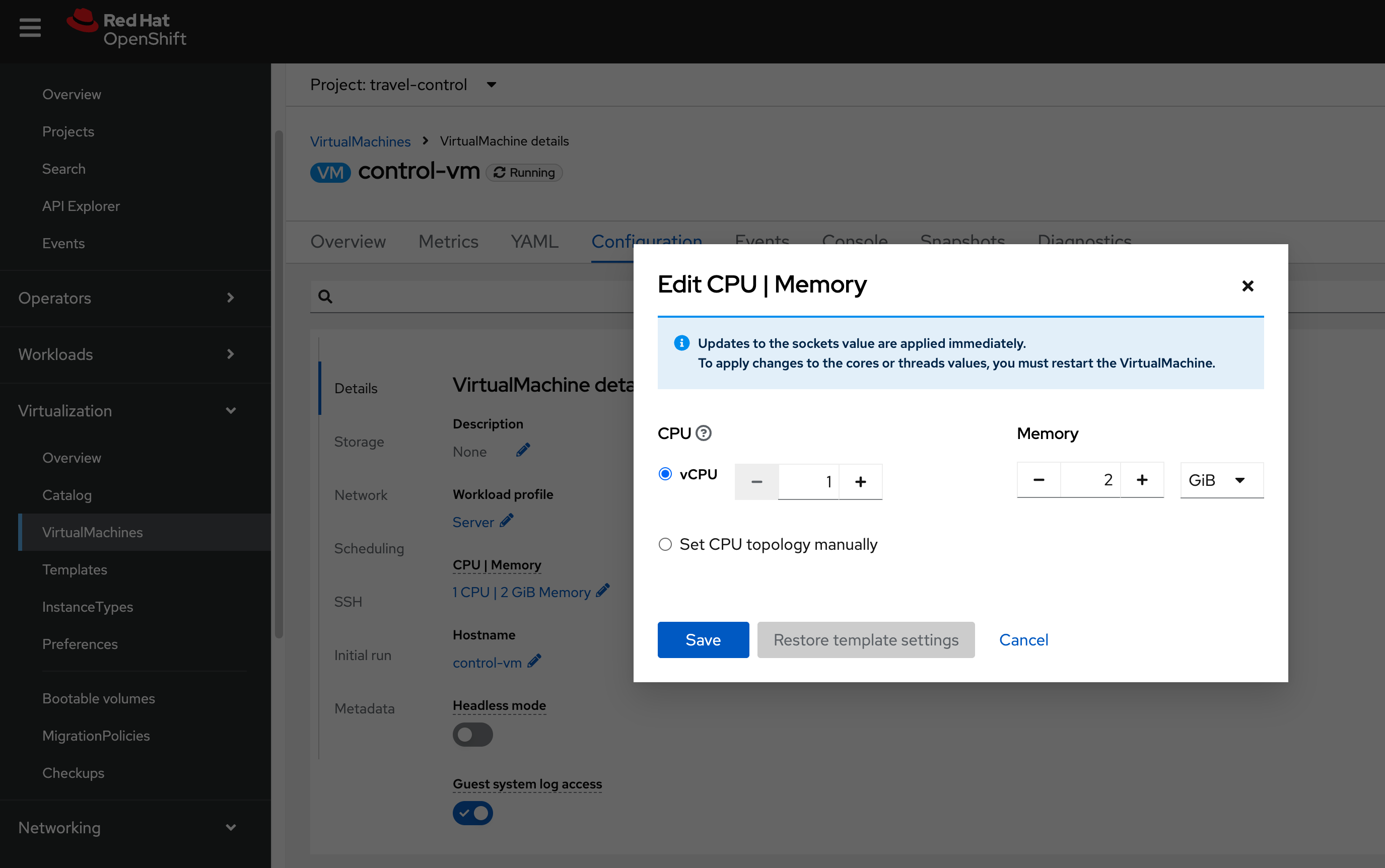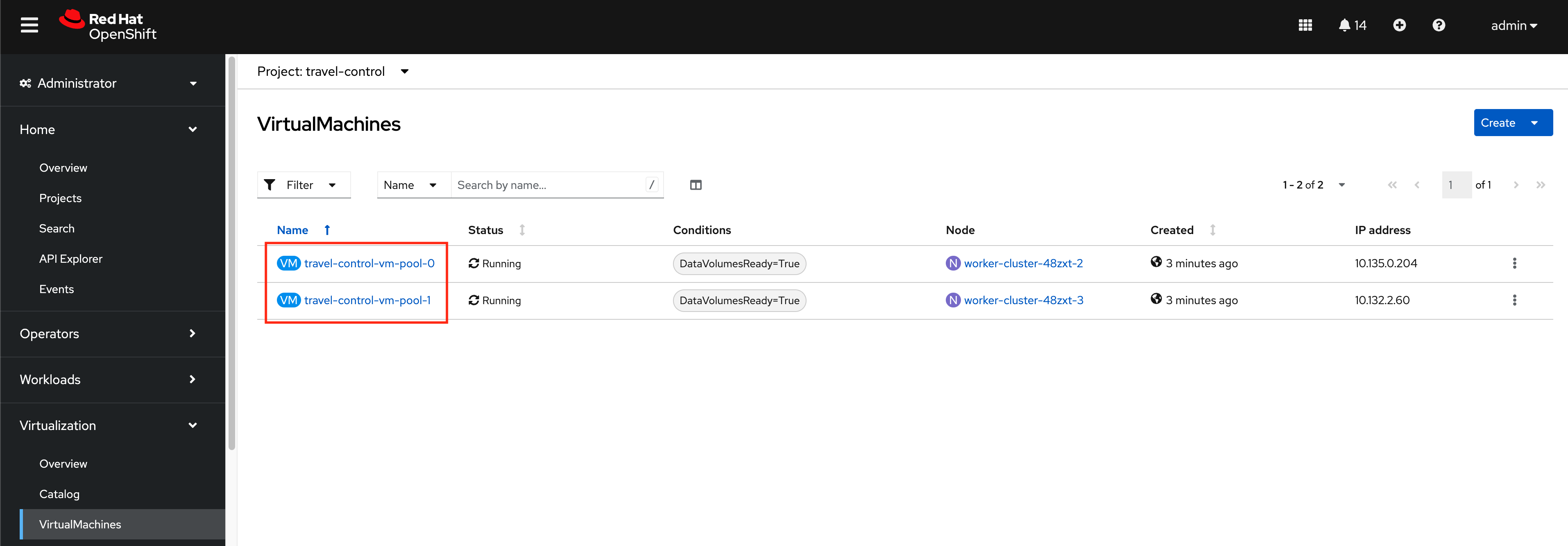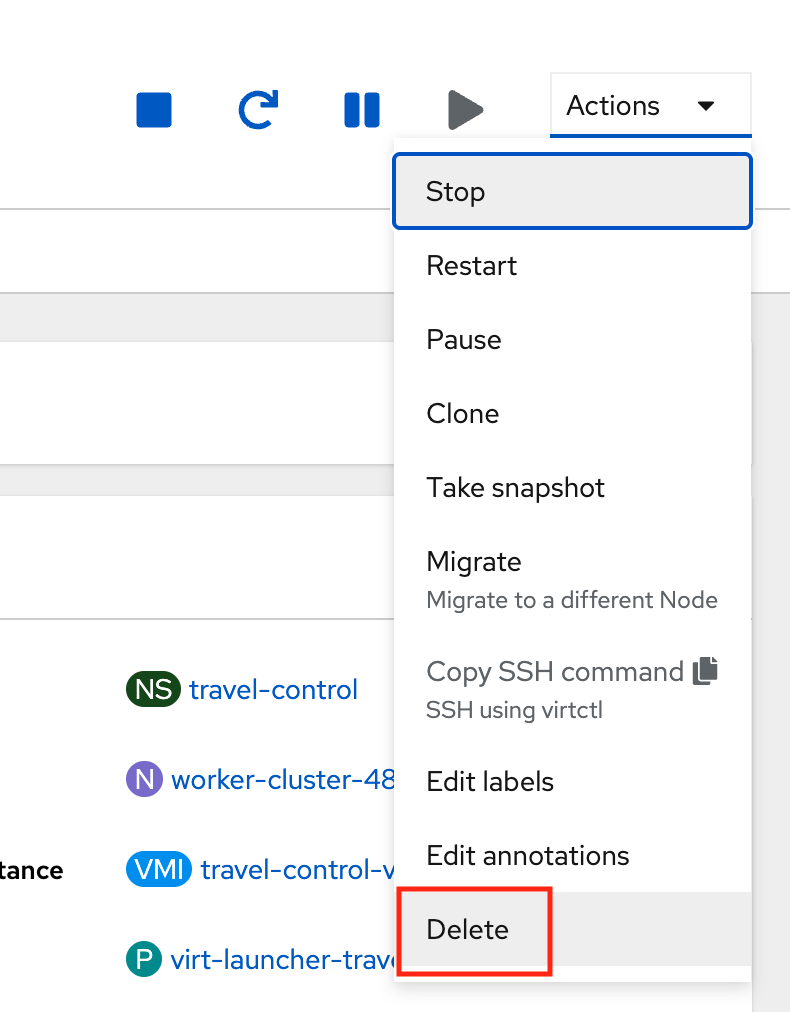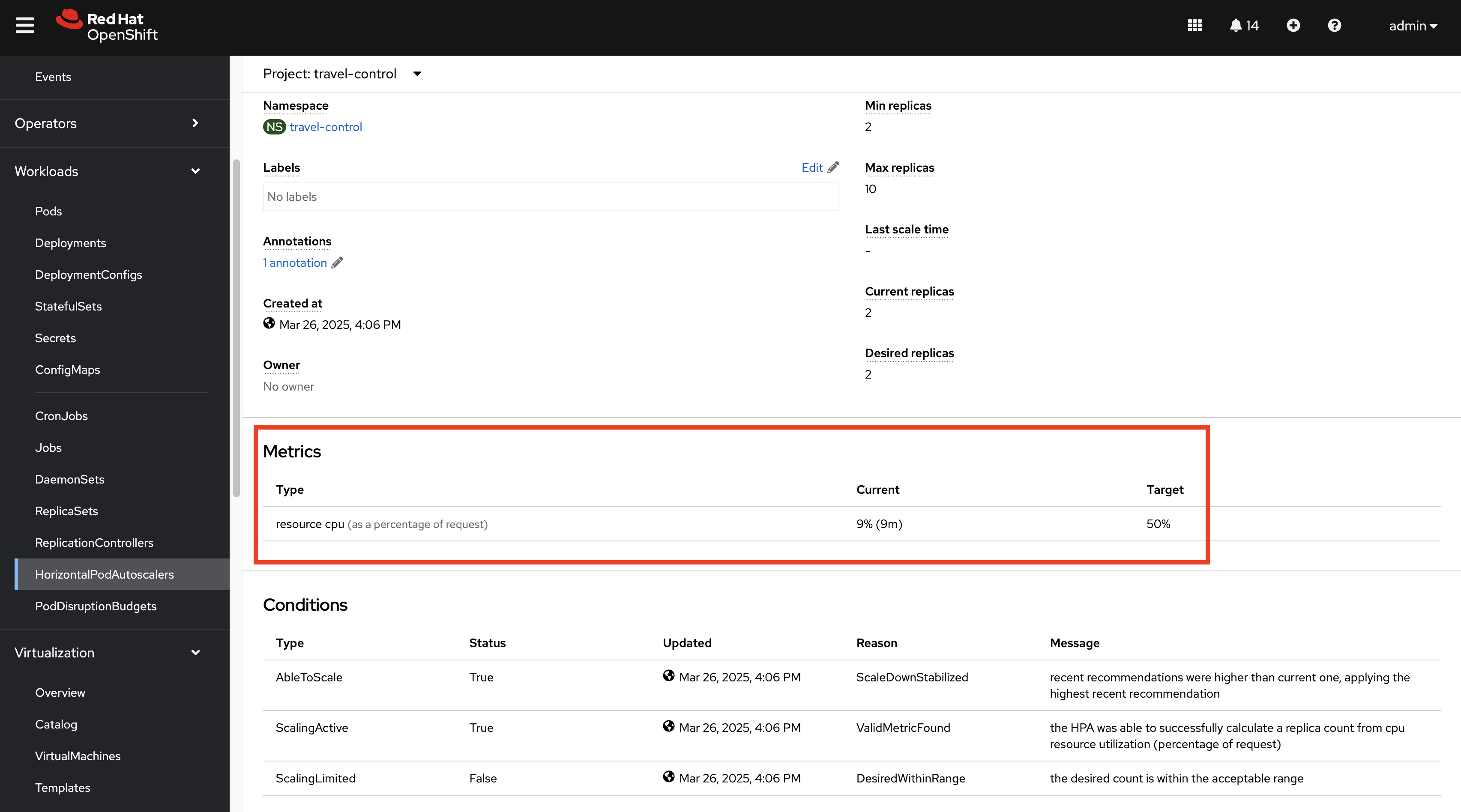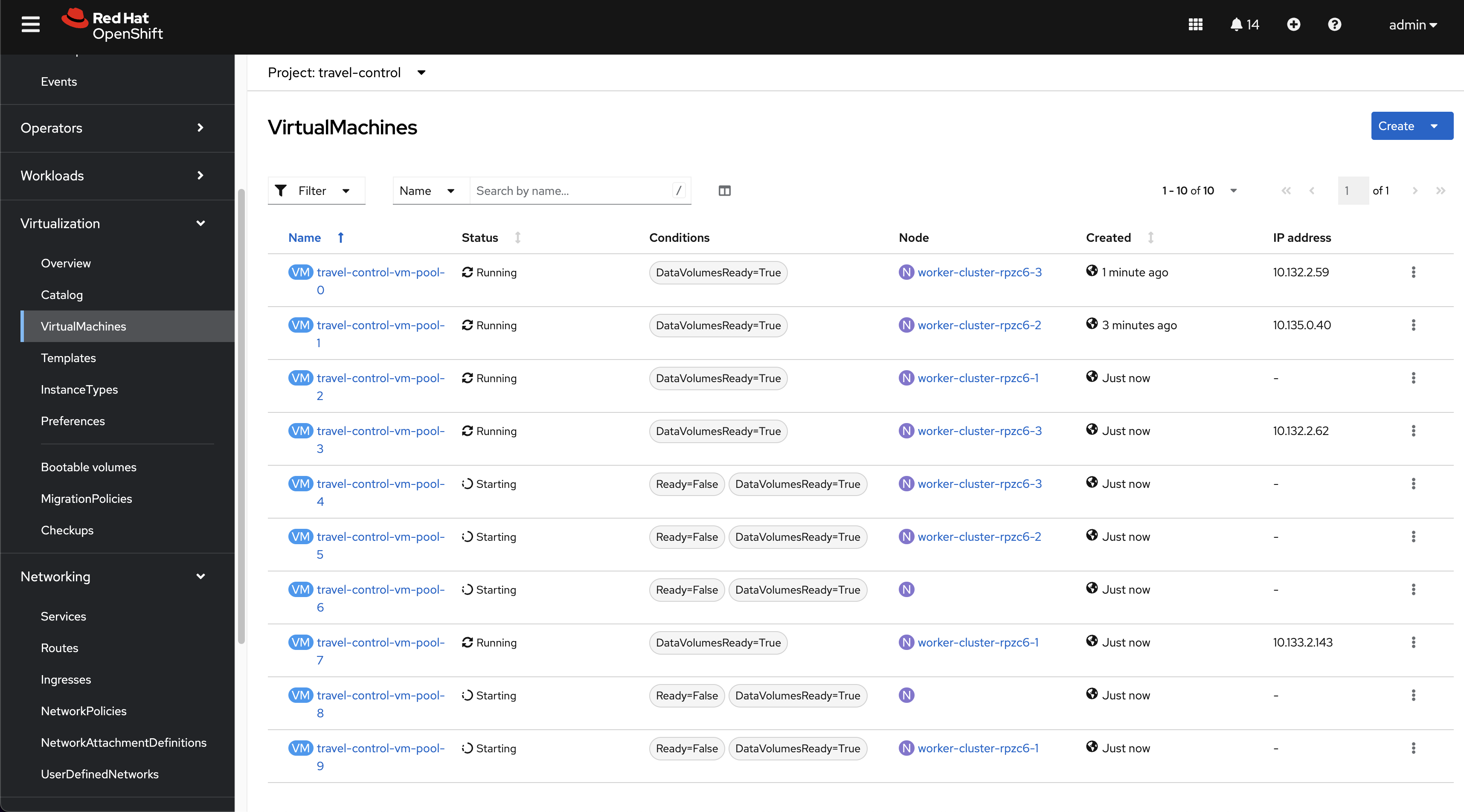Module 2 - Scaling Virtual Machines on OpenShift
All assets for this module are in the folder lab-2. Please change the directory into this folder.
|
cd $HOME/virt-ossm-workspace/lab-2Task 1: Complete the Travel Demo Application - Create the UI component
Let us revisit the application architecture.
As of now all backend services are running as virtual machines in the travel-agency namespace.
In the travel-portal namespace we have three Customer Portals running in the form of containers.
What is missing, is the business dashboard (Simulator) in the travel-control namespace.
This component provides an UI and simulates sending booking requests to the booking portals.
We are going to deploy this component now as a virtual machine.
First we create a new OpenShift project (namespace) for this Virtual machine:
oc new-project travel-controlThen go to Virtualization → VirtualMachines → Create
Select With YAML and replace the content with the following:
apiVersion: kubevirt.io/v1
kind: VirtualMachine
metadata:
name: control-vm
namespace: travel-control
spec:
dataVolumeTemplates:
- apiVersion: cdi.kubevirt.io/v1beta1
kind: DataVolume
metadata:
creationTimestamp: null
name: fedora-control
spec:
sourceRef:
kind: DataSource
name: fedora
namespace: openshift-virtualization-os-images
storage:
resources:
requests:
storage: 30Gi
running: true
template:
metadata:
annotations:
vm.kubevirt.io/flavor: small
vm.kubevirt.io/os: fedora
vm.kubevirt.io/workload: server
# sidecar.istio.io/inject: 'true'
creationTimestamp: null
labels:
kubevirt.io/domain: control-vm
kubevirt.io/size: small
app: control-vm
version: v1
spec:
architecture: amd64
domain:
cpu:
cores: 1
sockets: 1
threads: 1
devices:
disks:
- disk:
bus: virtio
name: rootdisk
- disk:
bus: virtio
name: cloudinitdisk
interfaces:
- masquerade: {}
name: default
rng: {}
features:
acpi: {}
smm:
enabled: true
firmware:
bootloader:
efi: {}
machine:
type: pc-q35-rhel9.4.0
memory:
guest: 2Gi
resources: {}
networks:
- name: default
pod: {}
terminationGracePeriodSeconds: 180
volumes:
- dataVolume:
name: fedora-control
name: rootdisk
- cloudInitNoCloud:
userData: |-
#cloud-config
user: fedora
password: ukqo-2vq4-xdjf
chpasswd: { expire: False }
ssh_pwauth: true
runcmd:
- loginctl enable-linger fedora
- su - fedora -c 'XDG_RUNTIME_DIR=/run/user/$(id -u) DBUS_SESSION_BUS_ADDRESS="unix:path=${XDG_RUNTIME_DIR}/bus" systemctl --user daemon-reload'
- su - fedora -c 'XDG_RUNTIME_DIR=/run/user/$(id -u) DBUS_SESSION_BUS_ADDRESS="unix:path=${XDG_RUNTIME_DIR}/bus" systemctl --user start control.service'
write_files:
- content: |
[Unit]
Description=Fedora Control Container
[Container]
Label=app=control-container
ContainerName=control-container
Image=quay.io/kiali/demo_travels_control:v1
Environment=PORTAL_SERVICES='voyages.fr;http://voyages.travel-portal.svc.cluster.local:8000,viaggi.it;http://viaggi.travel-portal.svc.cluster.local:8000,travels.uk;http://travels.travel-portal.svc.cluster.local:8000'
PodmanArgs=-p 8080:8080
[Install]
WantedBy=multi-user.target default.target
[Service]
Restart=always
path: /etc/containers/systemd/users/control.container
permissions: '0777'
owner: root:root
name: cloudinitdiskClick on Create.
The Virtual Machine instance is going to be provisioned now. After a minute or two, the VM should be up and running:
Task 2: Expose the Business Dashboard
The business dashboard is now running and sending booking request to the booking portals. In order to access the UI of the Dashboard from our Browser, we have to create a Kubernetes Service and expose this Service with an OpenShift Route, like we did in Module 1.
First create the Kubernetes services:
apiVersion: v1
kind: Service
metadata:
name: control-vm
namespace: travel-control
labels:
app: control-vm
spec:
ports:
- port: 8080
name: http
selector:
kubevirt.io/domain: control-vmoc apply -f ./control-svc.yamlNow expose the service with a route:
kind: Route
apiVersion: route.openshift.io/v1
metadata:
name: travel-control
namespace: travel-control
spec:
to:
kind: Service
name: control-vm
weight: 100
port:
targetPort: http
tls:
termination: edge
insecureEdgeTerminationPolicy: Allow
wildcardPolicy: Noneoc apply -f ./control-route.yaml| You can access the dashboard now through https or http as we have configured TLS with edge termination. |
Or use the CLI to get the URL:
echo "$(oc get route travel-control -o jsonpath='{.spec.host}' -n travel-control)"| Congratulations!! You helped the Travel Agency company to have their complete Booking system running in OpenShift with VMs alongside containers. |
Task 3: Scale Up the control-vm
The busines dashboard is the central UI component in the Travel Booking application. Therefore we want to increase the cpu and memory. The VM instance is currently configured with 1 cpu and 2GB of memory. Let us validate this.
Now we see that the VM is in the state migrating. The changes will automatically be applied.
| OpenShift Virtualization also supports Live Migration when increasing resources, so it can migrate VMs across nodes for better resource utilization. The underlying node must have enough available resources for scaling up. |
Congratulations! You have scaled up a Virtual Machine.
Task 4: Scale Out a VM to showcase the loadbalancing ability in OCP
As we have mentioned already, there are three options to scale out VMs.
We are going to use a VirtualMachinePool resource in this task.
|
Please note that |
A VirtualMachinePool tries to ensure that a specified number of VirtualMachine replicas and their respective VirtualMachineInstances are in the ready state at any time. In other words, a VirtualMachinePool makes sure that a VirtualMachine or a set of VirtualMachines is always up and ready.
First we are going to delete the existing control-vm Virtual Machine:
oc delete vm control-vm -n travel-controlAnd replace it with a VirtualMachinePool configuration.
The actual interesting parts are the spec.replicas and the matchLabels selectors. In this case we want to have 2 replicas of this VM running at any time.
apiVersion: pool.kubevirt.io/v1alpha1
kind: VirtualMachinePool
metadata:
name: travel-control-vm-pool
namespace: travel-control
spec:
replicas: 2
selector:
matchLabels:
kubevirt.io/domain: control-vm
virtualMachineTemplate:
metadata:
..
spec:
runStrategy: Always
..
template:
metadata:
..
labels:
kubevirt.io/domain: control-vm
kubevirt.io/size: small
app: control-vm
version: v1
spec:
architecture: amd64
domain:
cpu:
cores: 1
sockets: 1
threads: 1
..
..
..Now let’s apply the VirtualMachinePool configuration:
oc apply -f ./vm-pool.yamlOpen the business dashboard and validate that it is still working.
You will also recognize that the control-vm is automatically recreated.
| It is also possible to autoscale Virtual Machines by using a HorizontalPodAutoscaler (HPA) with a VirtualMachinePool. |
Simply reference it in the spec of the autoscaler:
apiVersion: autoscaling/v1
kind: HorizontalPodAutoscaler
metadata:
name: vm-pool-hpa
namespace: travel-control
spec:
maxReplicas: 10
minReplicas: 2
scaleTargetRef:
apiVersion: pool.kubevirt.io/v1alpha1
kind: VirtualMachinePool
name: travel-control-vm-pool
targetCPUUtilizationPercentage: 50
oc apply -f ./vm-pool-hpa.yamlNow the HorizontalPodAutoscaler will scale up to 10 instances if the CPU utilization exceeds 50%.
We clean up by deleting the HorizontalPodAutoscaler and scaling down the VirtualMachinePool to 1 replica:
oc delete hpa vm-pool-hpa -n travel-control
oc patch virtualmachinepool travel-control-vm-pool --type merge --patch '{"spec":{"replicas":1}}'